Charles E W Bean, Diaries, AWM38 3DRL 606/253/1 - 1918 - 1939 - Part 1
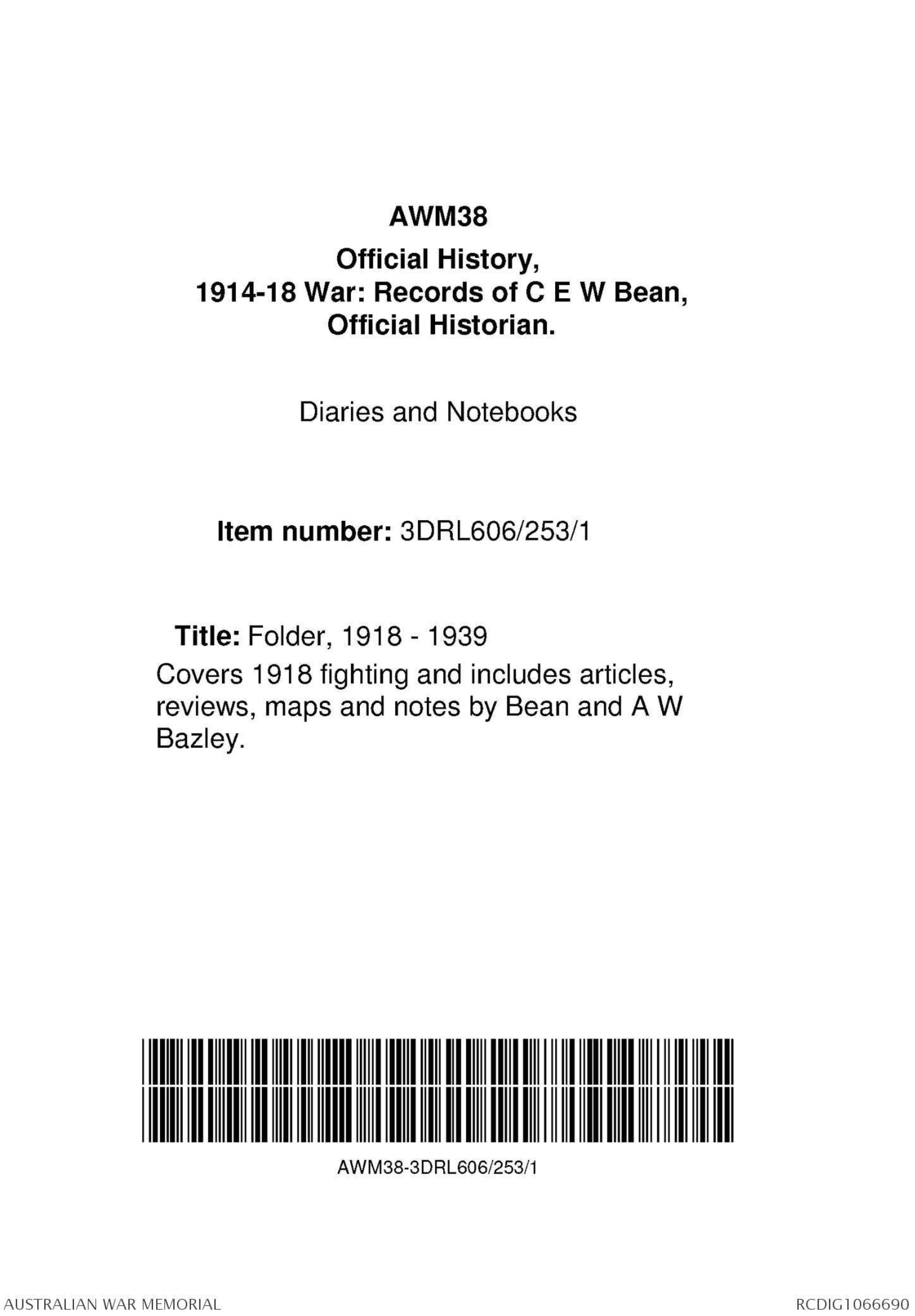
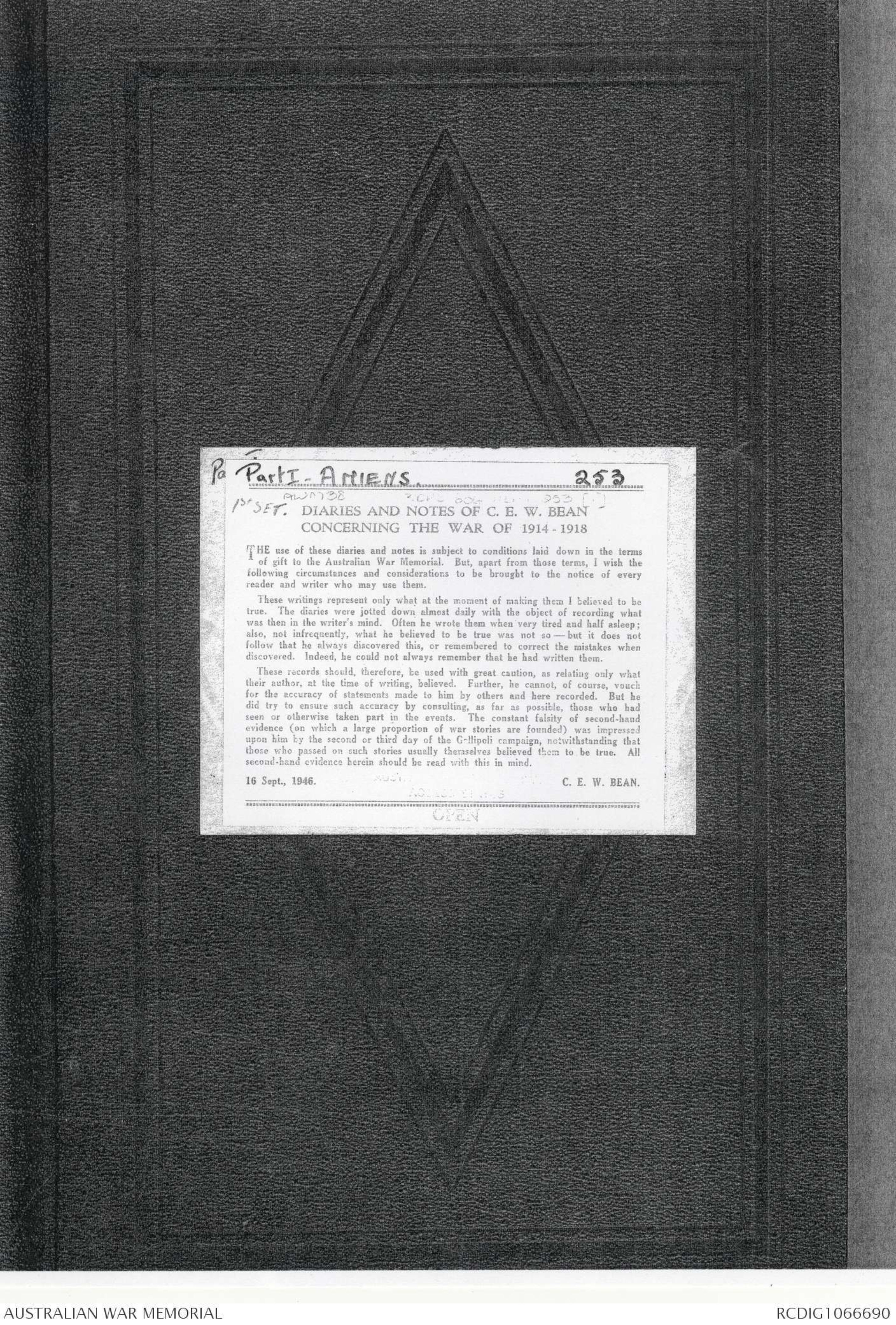
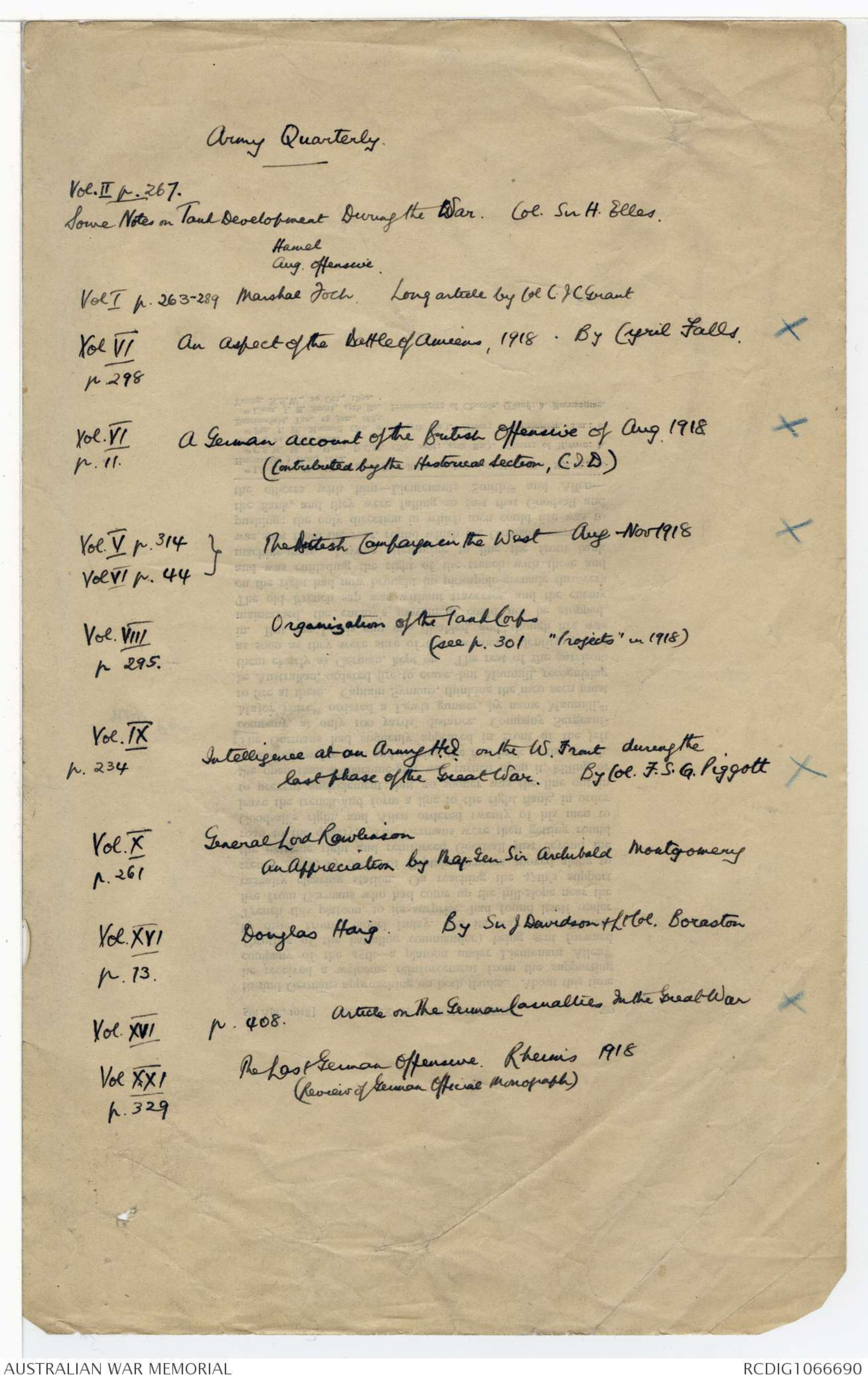
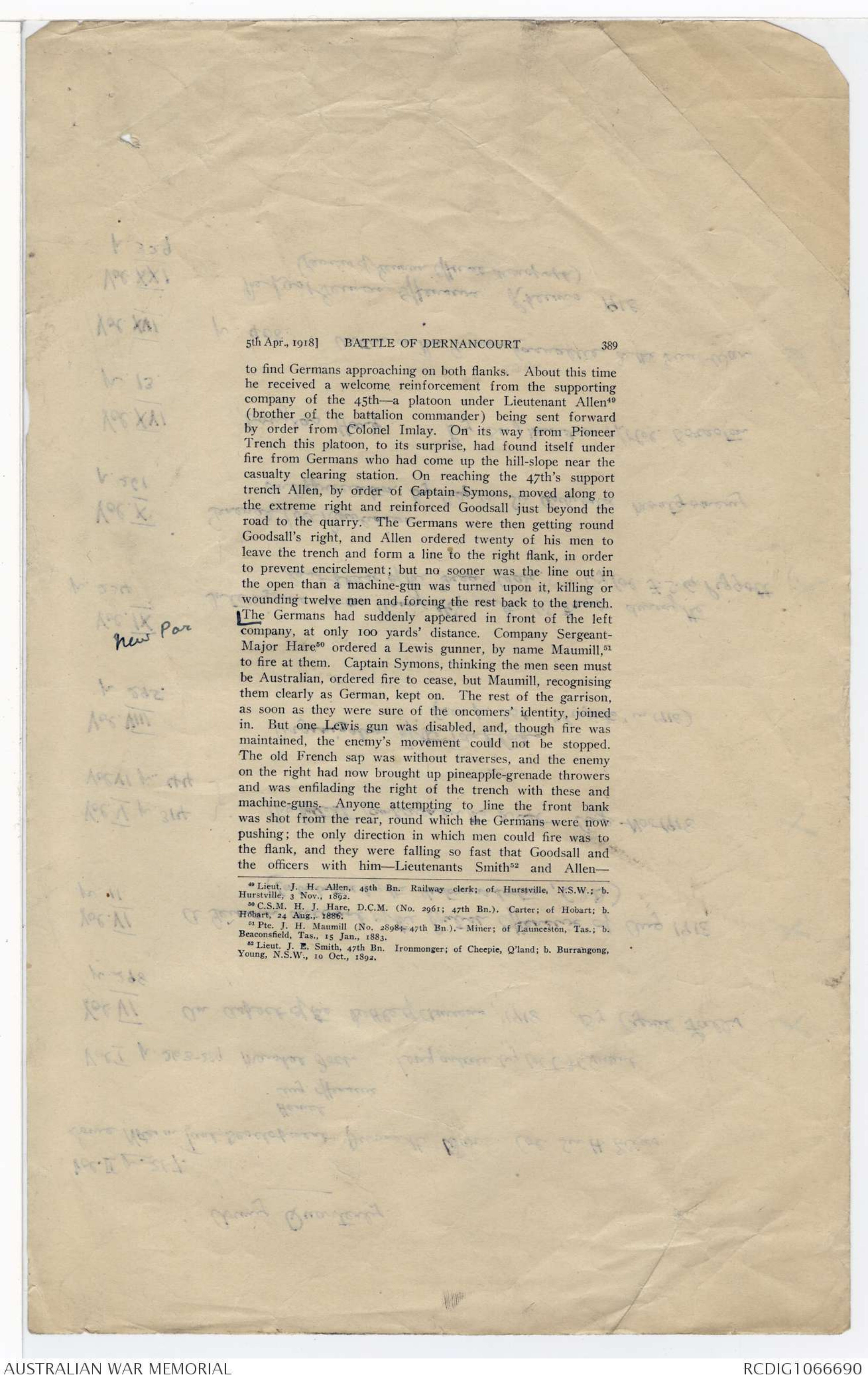
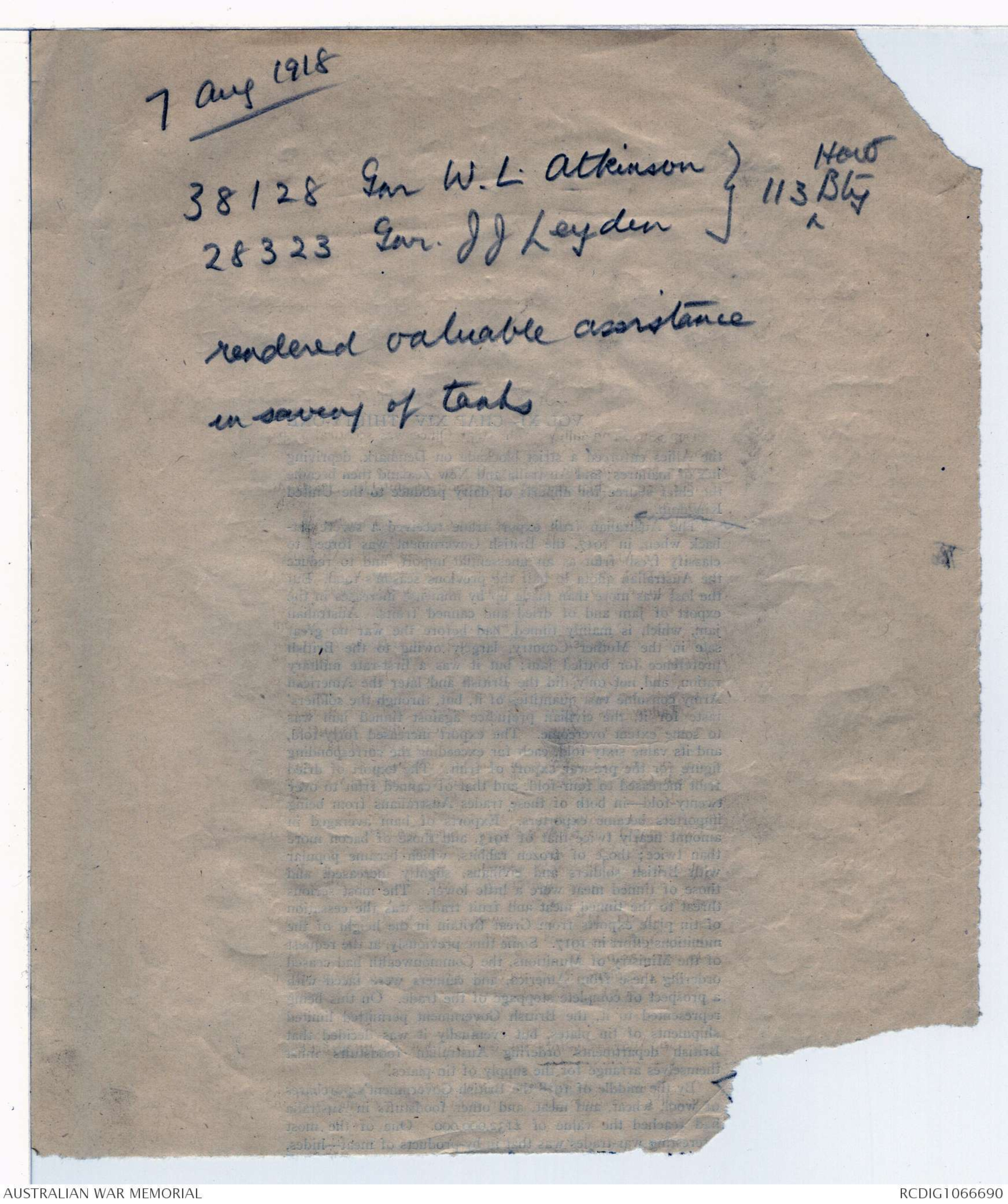
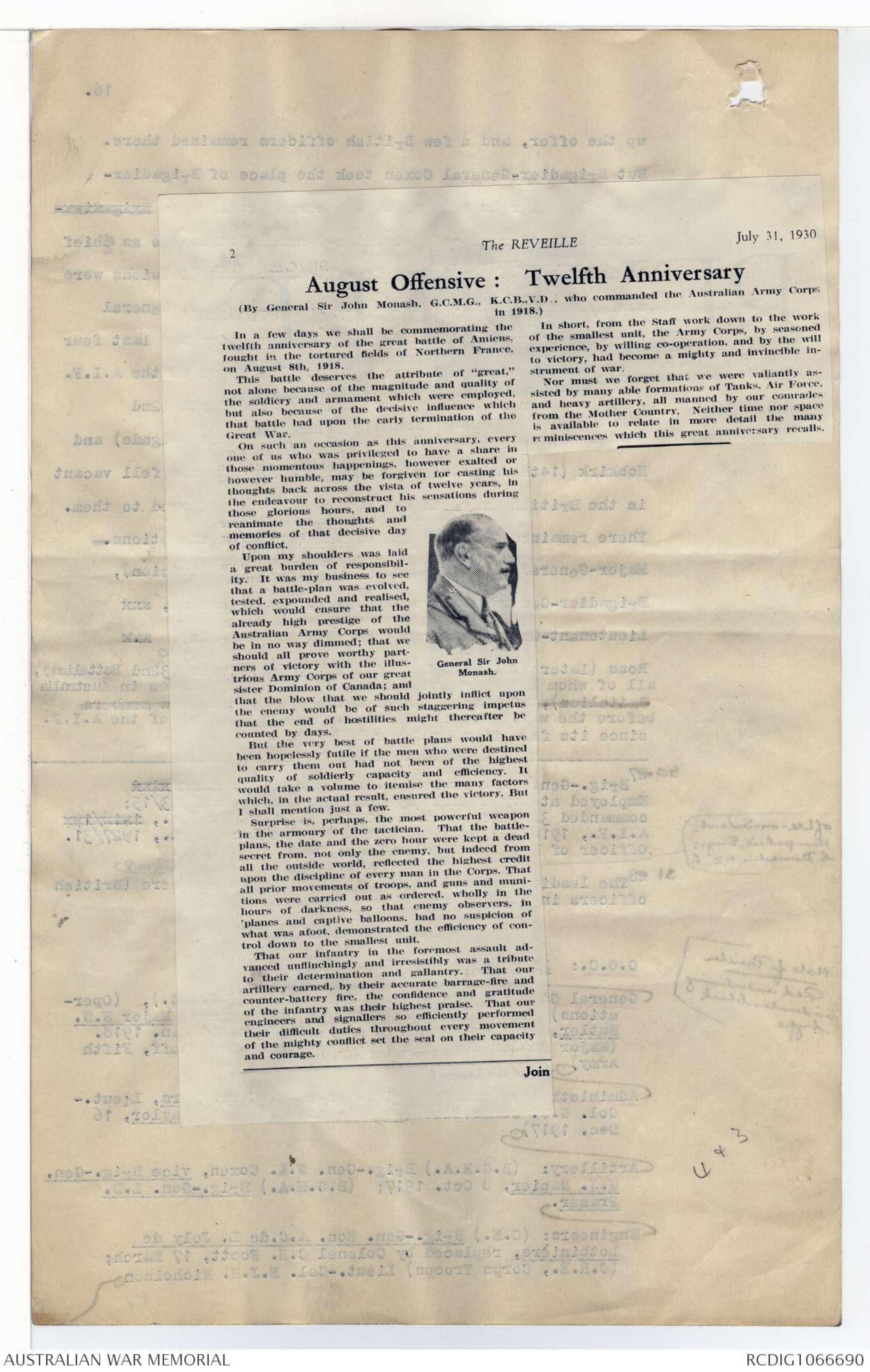
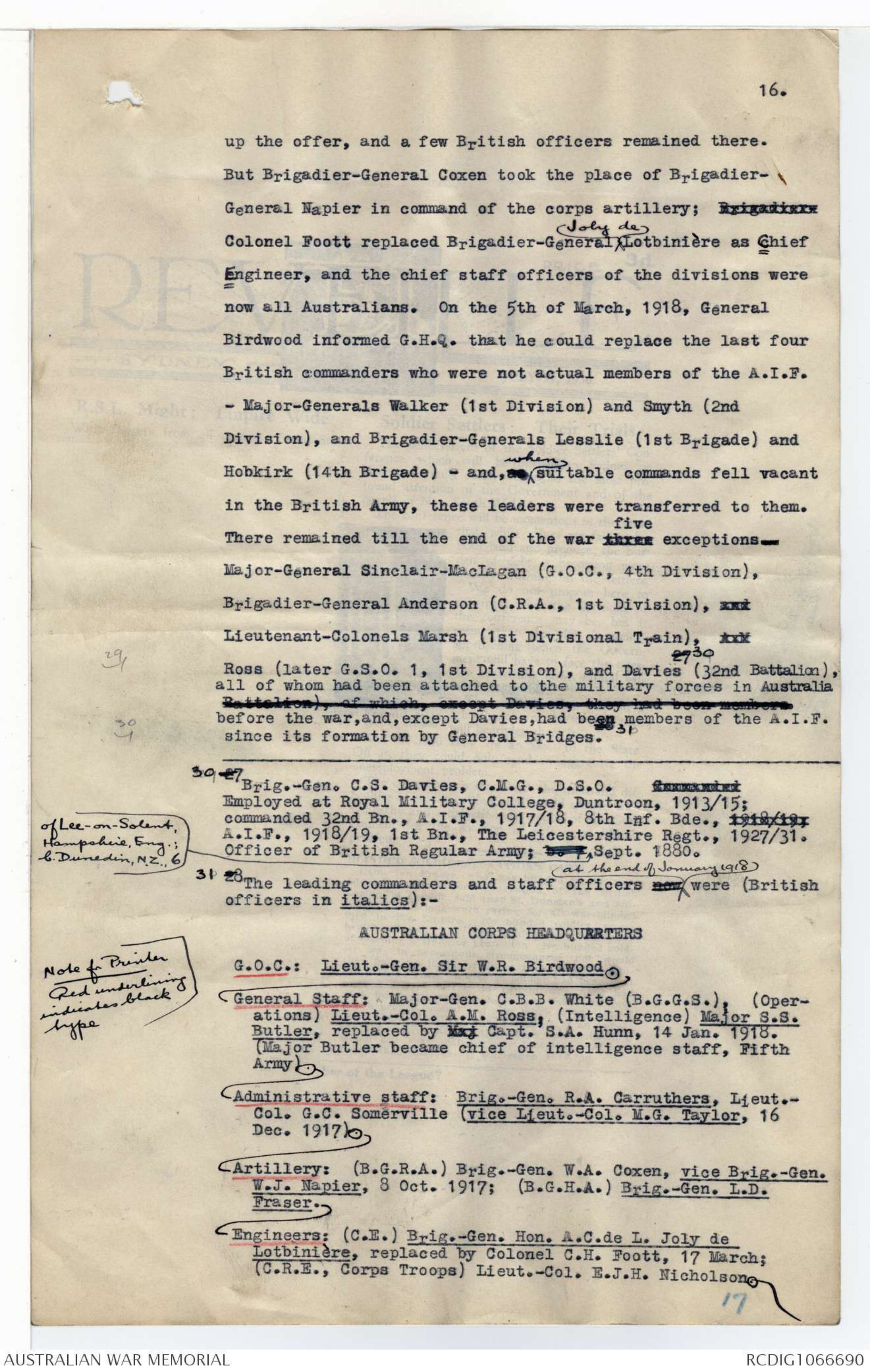
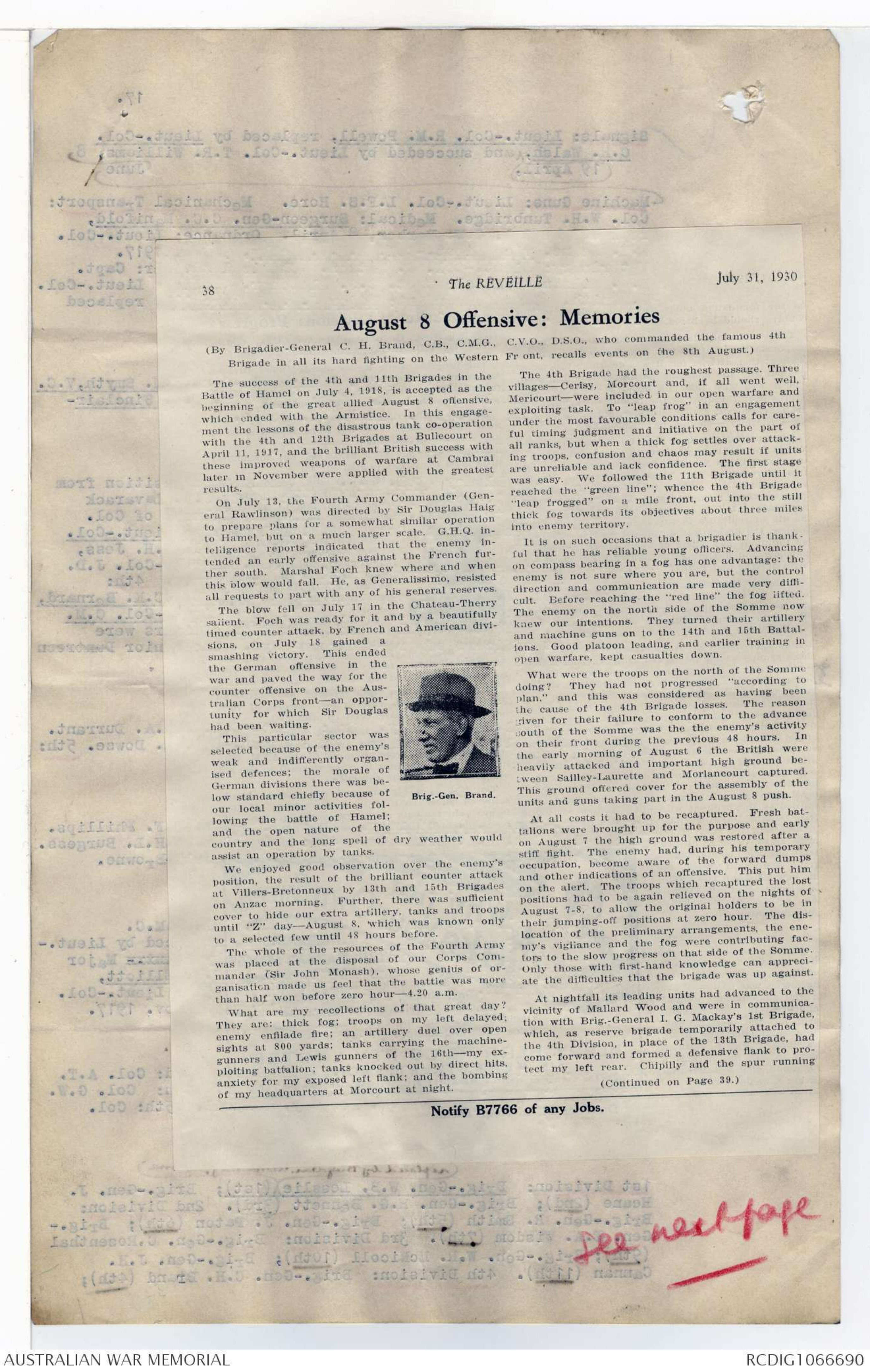
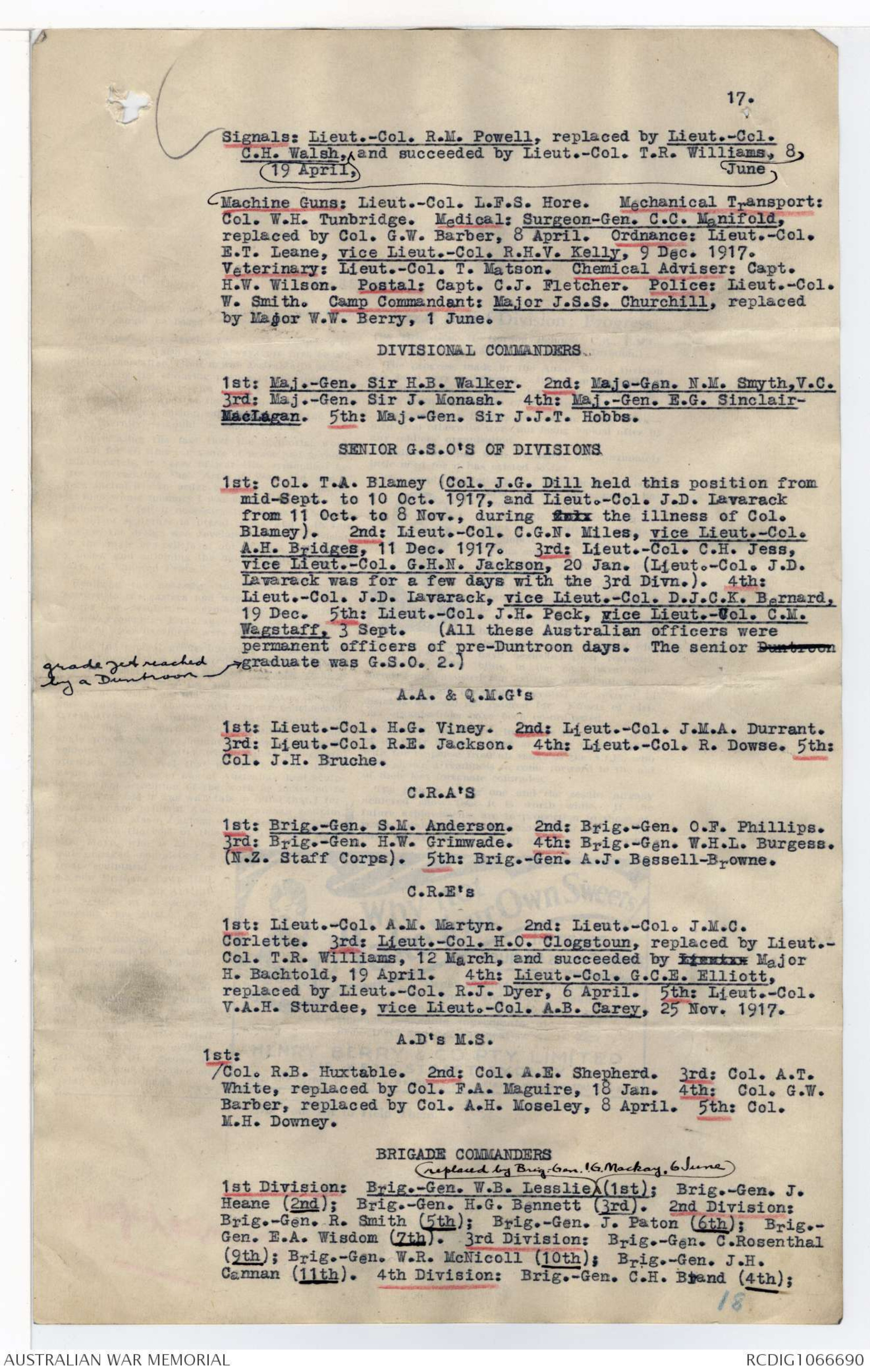
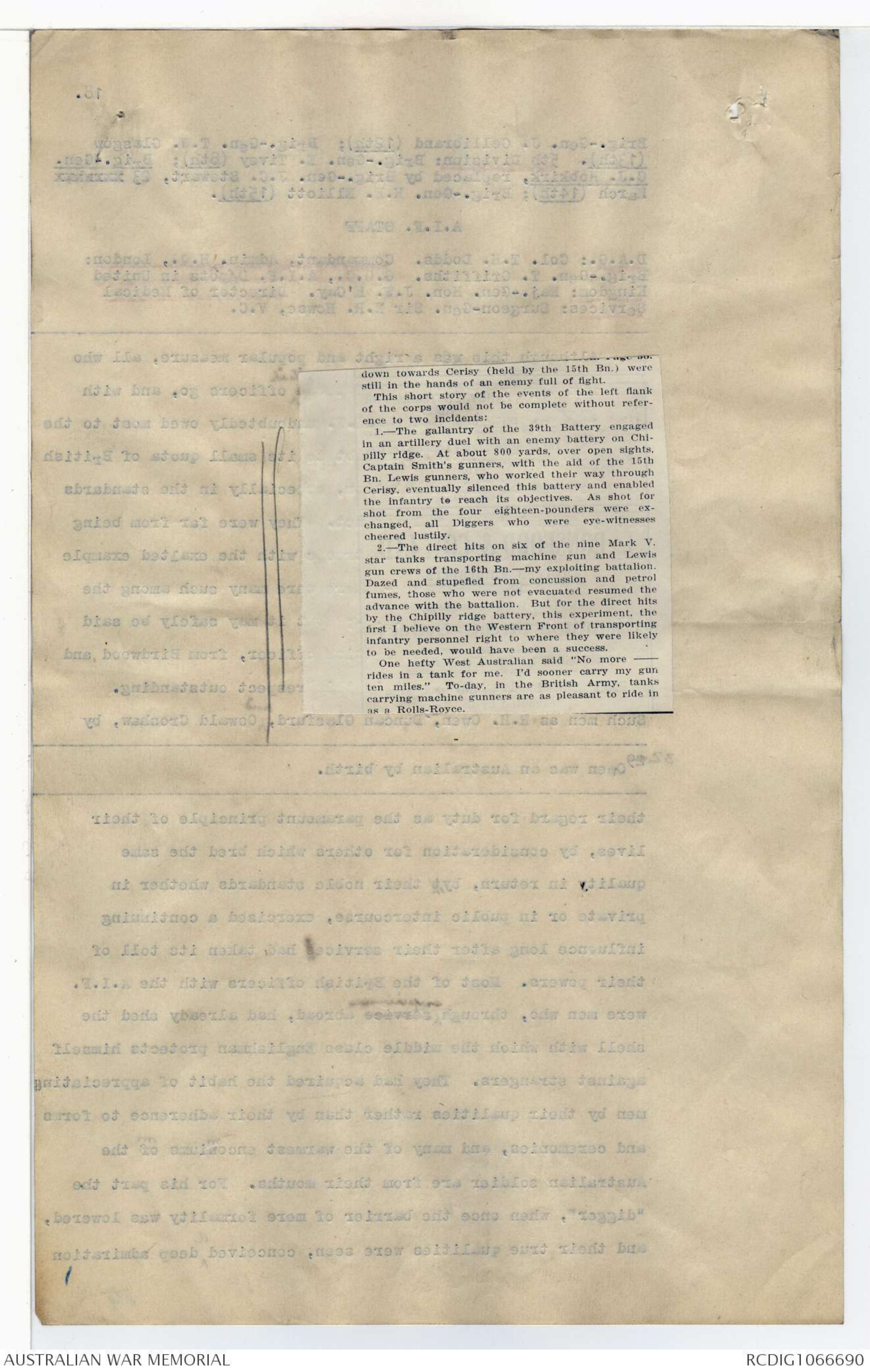
AWM38
Official History,
1914-18 War: Records of C E W Bean,
Official Historian.
Diaries and Notebooks
Item number: 3DRL606/253/1
Title: Folder, 1918 - 1939
Covers 1918 fighting and includes articles,
reviews, maps and notes by Bean and A W
Bazley.
AWM38-3DRL606/253/1
Part 1 - AMIENS. 253
AWM38 3DRL 606 ITEM 253 [1]
1st SET. DIARIES AND NOTES OF C. E. W. BEAN
CONCERNING THE WAR OF 1914 - 1918
THE use of these diaries and notes is subject to conditions laid down in the terms
of gift to the Australian War Memorial. But apart from these terms, I wish the
following circumstances and considerations to be brought to the notice of every
reader and writer who may use them.
These writings represent only what at the moment of making them I believed to be
true. The diaries were jotted down almost daily with the object of recording what
was then in the writer's mind. Often he wrote them when very tired and half-asleep;
also, not infrequently what he believed to be true was not so - but it does not
follow that he always discovered this, or remembered to correct the mistakes when
discovered. Indeed, he could not always remember that he had written them.
These records should therefore, be used with great caution, as relating only what
their author, at the time of writing believed. Further, he cannot, of course vouch
for the accuracy of statements made to him by others and here recorded. But he
did try to ensure such accuracy by consulting, as far as possible, those who had
seen or otherwise taken part in the events. The constant falsity of second-hand
evidence (on which a large proportion of war stories are founded) was impressed
upon him by the second or third day of the Gallipoli campaign, notwithstanding that
those who passed on such stories usually themselves believed them to be true. All
second-hand evidence herein should be read with this in mind.
16 Sept., 1946. C. E. W. BEAN
AUSTRALIAN WAR MEMORIAL
ACCESS STATUS
OPEN
Army Quarterly.
Vol. II p. 267.
Some Notes on Tank Development During the War. Col Sir H. Elles.
Hamel
Aug. Offensive.
Vol I p. 263-289 Marshal Foch. Long article by Col C J C Grant
Vol VI p.298 An aspect of the Battle of Amiens, 1918 . By Cyril Falls. X
Vol. VI p.11. A German account of the British Offensive of Aug 1918 X
(contributed by the Historical Section, C 2 D)
Vol. V p. 314}
Vol. VI p. 44} The British Campaign in the West Aug - Nov 1918 X
Vol. VIII p 295. Organization of the Tank Corps
(see p.301 "Projects" in 1918)
Vol. IX p.234 Intelligence at an Army H.Q. on the W. Front during the
last phase of the Great War. By Col. F.S.G. Piggott X
Vol. X p. 261 General Lord Rawlinson
An Appreciation by Maj. Gen Sir Archibald Montgomery
Vol. XVI p. 13. Douglas Haig. By Sir J Davidson & Lt Col Boraston
Vol. XVI p. 408. Article on The German Casualties In the Great War X
Vol XXI p. 329 The Last German Offensive. Rheims 1918
(Review of German Official Monograph)
389
5th Apr., 1918] BATTLE OF DERNANCOURT
to find Germans approaching on both flanks. About this time
he received a welcome reinforcement from the supporting
company of the 45th—a platoon under Lieutenant Allen49
(brother of the battalion commander) being sent forward
by order from Colonel Imlay. On its way from Pioneer
Trench this platoon, to its surprise, had found itself under
fire from Germans who had come up the hill-slope near the
casualty clearing station. On reaching the 47th's support
trench Allen, by order of Captain Symons, moved along to
the extreme right and reinforced Goodsall just beyond the
road to the quarry. The Germans were then getting round
Goodsall's right, and Allen ordered twenty of his men to
leave the trench and form a line to the right flank, in order
to prevent encirclement; but no sooner was the line out in
the open than a machine-gun was turned upon it, killing or
wounding twelve men and forcing the rest back to the trench.
[*New Par*]
The Germans had suddenly appeared in front of the left
company, at only 100 yard's distance. Company Sergeant-
Major Hare50 ordered a Lewis gunner, by the name Maumill,51
to fire at them. Captain Symons, thinking the men seen must
be Australian, ordered fire to cease, but Maumill, recognising
them clearly as German, kept on. The rest of the garrison,
as soon as they were sure of the oncomers' identity, joined
in. But one Lewis gun was disabled, and, though fire was
maintained. the enemy's movement could not be stopped.
The old French sap was without traverses, and the enemy
on the right now brought up pineapple-grenade throwers
and was enfilading the right of the trench with these and
machine-guns. Anyone attempting to line the front bank
was shot from the rear, round which the Germans were now
pushing; the only direction in which men could fire was to
the flank, and they were falling so fast that Goodsall and
the officers with him—Lieutenants Smith52 and Allen—
_____________________________________________________
49Lieut. J. H. Allen, 45th Bn. Railway clerk; of Hurstville, N.S.W.; b.
Hurstville, 3 Nov., 1892.
50C.S.M. H.J.Hare, D.C.M. (No.2961; 47th Bn.). Carter; of Hobart; b.
Hobart, 24 Aug., 1886.
51Pte. J. H. Maumill (No. 28989 - 47th Bn.). Miner; of Launceston, Tas.; b. Beaconsfield, Tas., 15 Jan., 1883.
52Lieut. J. E. Smith, 47th Bn. Ironmonger; of Cheepie, Q'land; b. Burrangong,
Young, N.S.W., 10 Oct., 1892.
7 Aug 1918
38128 Gnr W.L. Atkinson )
28323 Gnr. J J Leyden ) 113 ^How Bty
rendered valuable assistance
in saving of tanks
2 The REVEILLE July 31, 1930
August Offensive : Twelfth Anniversary
(By General Sir John Monash, G.C.M.G., K.C.B., V.D., who commanded the Australian Army Corps
in 1918.)
In a few days we shall be commemorating the
twelfth anniversary of the great battle of Amiens,
fought on the tortured fields of Northern France
on August 8th, 1918.
This battle deserves the attribute of "great,"
not alone because of the magnitude and quality of
the soldiery and armament which were employed,
but also because of the decisive influence which
that battle had upon the early termination of the
Great War.
On such an occasion as this anniversary, every
one of us who was privileged to have a share in
those momentous happenings, however exalted or
however humble, may be forgiven for casting his
thoughts back across the vista of twelve years, in
the endeavour to reconstruct his sensations during
those glorious hours, and to
reanimate the thoughts and
memories of that decisive day
of conflict.
Upon my shoulders was laid
a great burden of responsibility.
it was my business to see
that a battle-plan was evolved,
tested, expounded and realised,
which would ensure that the
Australian Army Corps would
be in no way dimmed; that we
should all prove worthy partners
of victory with the illustrious
Army Corps of our great
sister Dominion of Canada; and
that the blow that we should jointly inflict upon
the enemy would be of such staggering impetus
that the end of hostilities might thereafter be
counted by days.
Photograph – see original document
General Sir John
Monash.
But the very best of battle plans would have
been hopelessly futile if the men who were destined
to carry them out had not been of the highest
quality of soldierly capacity and efficiency. It
would take a volume to itemise the many factors
which, in the actual result, ensured the victory. But
I shall mention just a few.
Surprise is, perhaps, the most powerful weapon
in the armoury of the tactician. That the battle-
plans, the date and the zero hour were kept a dead
secret from, not only the enemy, but indeed from
all the outside world, reflected the highest credit
upon the discipline of every man in the Corps. That
all prior movements of troops, and guns and munitions
were carried out as ordered, wholly in the
hours of darkness, so that enemy observers, in
'planes and captive balloons, had no suspicion of
what was afoot, demonstrated the efficiency of control
down to the smallest unit.
That our infantry in the foremost assault advanced
unflinchingly and irresistibly was a tribute
to their determination and gallantry. That our
artillery earned, by their accurate barrage-fire and
counter-battery fire, the confidence and gratitude
of the infantry was their highest praise. That our
engineers and signallers so efficiently performed
their difficult duties throughout every movement
of the mighty conflict set the seal on their capacity
and courage.
Join
In short, from the Staff work down to the work
of the smallest unit, the Army Corps, by seasoned
experience, by willing co-operation, and by the will
to victory, had become a mighty and invincible
instrument of war.
Nor must we forget that we were valiantly
assisted by many able formations of Tanks, Air Force,
and heavy artillery, all manned by our comrades
from the Mother Country. Neither time nor space
is available to relate in more detail the many
reminiscences which this great anniversary recalls.
16
up the offer, and a few British officers remained there.
But Brigadier-General Coxen took the place of Brigadier-
General Napier in command of the corps artillery; Brigadier
Colonel Foott replaced Brigadier-General ^Joly de Lotbiniēre as Chief
Engineer, and the chief staff officers of the divisions were
now all Australians. On the 5th of March, 1918, General
Birdwood informed G.H.Q. that he could replace the last four
British commanders who were not actual members of the A.I.F.
- Major-Generals Walker (1st Division) and Smyth (2nd
Division, and Brigadier-Generals Lesslie (1st Brigade) and
Hobkirk (14th Brigade) - and, xx ^when suitable commands fell vacant
in the British Army, these leaders were transferred to them.
There remained till the end of the war three five exceptions_
Major-General Sinclair-MacLagan (G.O.C., 4th Division),
Brigadier-General Anderson (C.R.A., 1st Division), and
Lieutenant-Colonels Marsh (1st Divisional Train), and
[*29→*] Ross (later G.S.O.1, 1st Division), and Davies 27 30 (32nd Battalion),
all of whom had been attached to the military force in AustraliaBattalion), of which, except Davies, they had been members
[*30→*] before the war, and except Davies, had been31 members of
since its formation by General Bridges.27 30 Brig-Gen. C.S. Davies, C.M.G., D.S.O. xxxxxxxx
Employed at Royal Military College, Duntroon, 1913/15;
commanded 32nd Bn., A.I.F., 1917/18, 8th Inf. Bde., 1918/19,
A.I.F. 1918/19, 1st Bn., The Leicestershire Regt., 1927/31.
Officer of British Regular Army;xxxx of Lee-on-Solent, Hampshire, Eng.;
b. Dunedin, N.Z., 6 Sept. 1880.28 31 The leading commanders and staff now ^at the end of January 1918 were (British
officers in italics):-
AUSTRALIAN CORPS HEADQUARTERS
[*Note for Printer
Red underlining
indicates black
type*]
G.O.C.: Lieut.-Gen. Sir W.R. Birdwood.
General Staff: Major-Gen. C.B.B. White (B.G.G.S.) (Operations) Lieut.-Col. A.M. Ross; (Intelligence) Major S.S.
Butler, replaced by Maj Capt. S.A. Hunn, 14 Jan. 1918.
(Major Butler became chief of intelligence staff, Fifth
Army).
Administrative staff: Brig.-Gen. R.A. Carruthers, Lieut.-
Col. G.C. Somerville (vice Lieut.-Col. M.G. Taylor, 16
Dec. 1917).
Artillery: (B.G.R.A.) Brig.-Gen. W.A. Coxen, vice Brig.-Gen.
W.J. Napier, 8 Oct. 1917; (B.G.H.A.) Brig.-Gen. L.D.
Fraser.
Engineers: (C.E.) Brig.-Gen. Hon. A.C.de L. Joly de
Lotbiniēre, replaced by Colonel C.H. Foott, 17 March;
(C.R.E., Corps Troops) Lieut.-Col. R.J.H. Nicholson.
17
38
The REVEILLE July 31, 1930
August 8 Offensive: Memories
(By Brigadier-General C.H. Brand, C.B., C.M.G., C.V.O., D.S.O., who commanded the famous 4th
brigade in all its hard fighting on the Western Front, recalls events on the 8th August.)
The success of the 4th and 11th Brigades in the
Battle of Hamel on July 4, 1918, is accepted as the
beginning of the great allied August 8 offensive,
which ended with the Armistice. In this engagement
the lessons of the disastrous tank co-operation
with the 4th and 12th Brigades at Bullecourt on
April 11, 1917, and the brilliant British success with
these improved weapons of warfare at Cambrai
later in November were applied with the greatest
results.
On July 13, the Fourth Army Commander (General
Rawlinson) was directed by Sir Douglad Haig
to prepare plans for a somewhat similar operation
to Hamel, but on a much larger scale. G.H.Q. intelligence
reports indicated that the enemy intended
an early offensive against the French further
south. Marshal Foch knew where and when
this blow would fall. He, as Generalissimo, resisted
all requests to part with any of his general reserves.
The blow fell on July 17 in the Chateau-Therry
salient. Foch was ready for it and by a beautifully
timed counter attack by French and American
divisions, on July 18 gained a
smashing victory. This ended
the German offensive in the
war and paved the way for the
counter offensive on the
Australian Corps front—an
opportunity for which Sir Douglas
had been waiting.
Photograph – see original document
Brig.-Gen. Brand.
This particular sector was
selected because of the enemy's
weak and indifferently organised
defences; the morale of
German divisions there was below
standard chiefly because of
our local minor activities following
the battle of Hamel;
and the open nature of the
country and the long spell of dry weather would
assist an operation by tanks.
We enjoyed good observation over the enemy's
position, the result of the brilliant counter attack
at Villers-Bretonneux by 13th and 15th Brigades
on Anzac morning. Further, there was sufficient
cover to hide our extra artillery, tanks and troops
until "Z" day—August 8, which was known only
to a selected few until 48 hours before.
The whole of the resources of the Fourth Army
was placed at the disposal of our Corps
Commander (Sir John Monash), whose genius of
organisation made us feel that the battle was more
than half won before zero hour - 4.20 a.m.
What are my recollections of that great day?
They are: thick fog; troops on my left delayed;
enemy enfilade fire; and artillery duel over open
sights at 800 yards; tanks carrying the machine-
gunners and Lewis gunners of the 16th—my
exploiting battalion; tanks knocked out by direct hits,
anxiety for my exposed left flank; and the bombing
of my headquarters at Morcourt at night.
The 4th Brigade had the roughest passage. Three
villages—Cerisy, Morcourt and. if all went well,
Mericourt—were included in our open warfare and
exploiting task. To "leap frog" in an engagement
under the most favourable conditions calls for careful
timing judgment and initiative on the part of
all ranks, but when a thick fog settles over attacking
troops, confusion and chaos may result if units
are unreliable and lack confidence. The first stage
was easy. We followed the 11th Brigade until it
reached the "green line"; whence the 4th Brigade
"leap frogged" on a mile front, out into the still
thick fog towards its objectives about three miles
into enemy territory.
It is on such occasions that a brigadier is thankful
that he has reliable young officers. Advancing
on compass bearing in a fog has one advantage: the
enemy is not sure where you are, but the control
direction and communication are made very difficult.
Before reaching the "red line" the fog lifted.
The enemy on the north side of the Somme now
knew our intentions. They turned their artillery
and machine guns on to the 14th and 15th Battalions.
Good platoon leading, and earlier training in
open warfare, kept casualties down.
What were the troops on the north of the Somme
doing? They had not progressed "according to
plan," and this was considered as having been
the cause of the 4th Brigade losses. The reason
given for their failure to conform to the advance
south of the Somme was the enemy's activity
on their front during the previous 48 hours. On
the early morning of August 6 the British were
heavily attacked and important high ground between
Sailley-Laurette and Moriancourt captured.
This ground offered cover for the assembly of the
units and guns taking part in the August 8 push.
At all costs it had to be recaptured. Fresh
battalions were brought up for the purpose and early
on August 7 the high ground was restored after a
stiff fight. The enemy had, during his temporary
occupation, become aware of the forward dumps
and other indications of an offensive. This put him
on the alert. The troops which recaptured the lost
positions had to be again relieved on the nights of
August 7-8, to allow the original holders to be in
their jumping-off positions at zero hour. The
dislocation of the preliminary arrangements, the
enemy's vigilance and the fog were contributing
factors to the slow progress on that side of the Somme.
Only those with first-hand knowledge can appreciate
the difficulties that the brigade was up against.
At nightfall its leading units had advanced to the
vicinity of Mallard Wood and were in communication
with Brig.-General I.G. Mackay's 1st Brigade,
which, as reserve brigade temporarily attached to
the 4th Division, in place of the 13th Brigade, had
come forward and formed a defensive flank to protect
my left rear. Chipilly and the spur running
(Continued on Page 39.)
Notify B7766 of any Jobs.
[*see next page*]
17.
Signals: Lieut.-Col. R.M. Powell, replaced by Lieut.-Col.
C.H.Walsh, ^19 April, and succeeded by Lieut.-Col. T.R. Williams, 8 June
Machine Guns: Lieut.-Col. L.F.S. Hore. Mechanical Transport:
Col. W.H. Tunbridge. Medical: Surgeon Gen. C.C. Manifold,
replaced by Col. G.W. Barber, 8 April. Ordnance: Lieut.-Col.
E.T. Leane, vice Lieut.-Col. R.H.V. Kelly, 9 Dec.1917.
Veterinary: Lieut.-Col. T. Matson. Chemical Adviser: Capt.
H.W. Wilson. Postal: Capt. C.J. Fletcher. Police: Lieut.-Col.
W.Smith. Camp Commandant: Major J.S.S. Churchill, replaced
by Major W.W. Berry, 1 June.
DIVISIONAL COMMANDERS
1st: Maj.-Gen. Sir H.B.Walker. 2nd: Maj.-Gen. N.M. Smyth, V.C.
3rd: Maj.-Gen. Sir J. Monash. 4th Maj.-Gen. E.G. Sinclair-
MacLagan. 5th: Maj.-Gen. Sir J.J.T. Hobbs.
SENIOR G.S.C'S OF DIVISIONS
1st: Col. T.A. Blamey (Col. J.G. Dill held this position from
mid-Sept. to 10 Oct. 1917, and Lieut.-Col. J.D. Lavarack
from 11 Oct to 8 Nov., during xxxx the illness of Col.
Blamey). 2nd: Lieut.-Col. C.G.N. Miles, vice Lieut.-Col.
A.H. Bridges, 11 Dec. 1917. 3rd: Lieut.-Col. C.H. Jess,
vice Lieut.-Col. G.H.N. Jackson, 20 Jan. (Lieut.-Col. J.D.
Lavarack was for a few days with the 3rd Divn.). 4th:
Lieut.-Col. J.D. Lavarack, vice Lieut.-Col. D.J.C.K. Barnard,
19 Dec. 5th: Lieut.-Col. J.H.Peck, vice Lieut.-Col. C.M.
Wagstaff, 3 Sept. (All these Australian officers were
permanent officers of pre-Duntroon days. The senior Duntroon
grade yet reached by a Duntroon graduate was G.S.O. 2.)
A.A. & Q.M.G's
1st: Lieut.-Col. H.G. Viney. 2nd: Lieut.-Col. J.M.A. Durrant.
3rd: Lieut.-Col. R.E. Jackson. 4th: Lieut.-Col. R. Dowse. 5th:
Col. J.H. Bruche.
C.R.A'S
1st: Brig.-Gen. S.M. Anderson. 2nd: Brig.-Gen. O.F. Phillips.
3rd: Brig.-Gen. H.W. Grimwade. 4th: Brig.-Gen. W.H.L. Burgess.
N.Z. Staff Corps). 5th: Brig.-Gen. A.J. Bessell-Browne.
A.D's M.S.
1st:/Col. R.B. Huxtable. 2nd: Col. A.E Shepherd. 3rd: Col. A.T.
White, replaced by Col. F.A. Maguire, 18 Jan. 4th: Col. G.W.
Barber, replaced by Col. A.H. Moseley, 8 April. 5th: Col.
M.H. Downey.
BRIGADE COMMANDERS
1st Division: Brig.-Gen. W.B. Lesslie ^replaced by Brib.-Gen. I.G. Mckay, 6 June (1st); Brig.-Gen. J.
Heane (2nd); Brig.-Gen. H.G. Bennett (3rd). 2nd Division:
Brig.-Gen. R. Smith (5th); Brig.-Gen. J. Paton (6th); Brig.-Gen.
E.A. Wisdom (7th). 3rd Division: Brig.-Gen. C.Rosenthal
(9th); Brig.-Gen. W.R. McNicoll (10th); Brig.-Gen. J.H.
Cannan (11th). 4th Division: Brig.-Gen. C.H. Brand (4th);
18
down towards Cerisy (held by the 11th Bn.) were
still in the hands of the enemy full of fight.
This short story of the events of the left flank
of the corps would not be complete without reference
to two incidents:
1.-The gallantry of the 39th Battery engaged
in an artillery duel with an enemy battery on Chipilly
ridge. At about 800 yards, over open sights,
Captain Smith's gunners, with the aid of the 15th
Bn. Lewis gunners, who worked their way through
Cerisy, eventually silenced this battery and enabled
the infantry to reach its objectives. As shot for
shot from the four eighteen-pounders were exchanged,
all Diggers who were eye witnesses
cheered lustily.
2/-The direct hits on six of the nine Mark V.
star tanks transporting machine gun and Lewis
gun crews of the 16th Bn.—my exploiting battalion.
Dazed and stupefied from concussion and petrol
fumes, those who were not evacuated resumed the
advance with the battalion. But for the direct hits
by the Chipilly ridge battery, this experiment, the
first I believe on the Western Front of transporting
infantry personnel right to where they were likely
to be needed, would have been a success.
One hefty West Australian said "No more —
rides in a tank for me. I'd sooner carry my gun
ten miles." To-day, in the British Army, tanks
carrying machine gunners are as pleasant to ride in
as a Rolls Royce.
 Sam scott
Sam scottThis transcription item is now locked to you for editing. To release the lock either Save your changes or Cancel.
This lock will be automatically released after 60 minutes of inactivity.